Carnegie Learning Algebra I Student Text Volume 1 3rd Edition Chapter 1 Quantities And Relationships
Page 54 Problem 1 Answer
Given: – is a smooth curve.
To graph of this function family. Method used: Functional method.
To find this function family;
Linear functions and linear absolute value functions are made up of line(s) so they are not smooth curves.
Both exponential functions and quadratic functions though are made up of smooth curves.
The correct families are then exponential function family an quadratic function family.
Exponential function family and quadratic function family is a smooth curve.
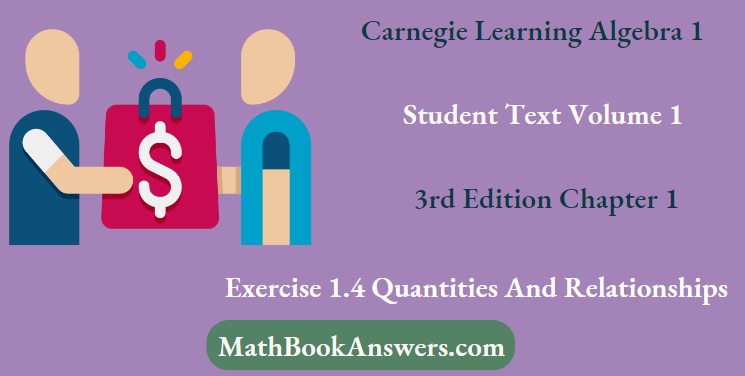
Page 54 Problem 2 Answer
Given: – is made up of one or more straight lines.To graph of this function family.
Method used: Functional method.
To find this function family;
Linear functions are made up of one straight line and linear absolute value functions are made up of two straight lines.
Exponential and quadratic functions are curves, not lines.
The correct families are then linear function family and linear absolute value function family.
Linear function family and linear absolute value function family is made up of one or more straight lines.
Carnegie Learning Algebra I Chapter 1 Exercise 1.4 Solutions
Carnegie Learning Algebra I Student Text Volume 1 3rd Edition Chapter 1 Exercise 1.4 Quantities And Relationships Page 54 Problem 3 Answer
Given: – increases or decreases over the entire domain.
To graph of this function family. Method used: Functional method.
To find the family;
Linear functions and exponential functions are either increasing over the entire domain or decreasing over the entire domain.
Quadratic functions and linear absolute value functions are both increasing and decreasing over the entire domain.
The correct families are then linear function family and exponential function family.
Linear and exponential increases or decreases over the entire domain.
Page 54 Problem 4 Answer
Given: – has a maximum or a minimum.To graph of this function family. Method used: Functional method.
To find the family;
Linear functions and exponential functions do not have a maximum or minimum since they are either increasing or decreasing over the entire domain.
Quadratic functions and linear absolute value functions are both increasing and decreasing over the entire domain which means they have a maximum or minimum.
The correct families are then quadratic function family and linear absolute value function family.
Quadratic and linear absolute value has a maximum or a minimum.
Carnegie Learning Algebra I Student Text Volume 1 3rd Edition Chapter 1 Exercise 1.4 Quantities And Relationships Page 54 Problem 5 Answer
Given: – is a smooth curve.To graph of this function family. Method used: Functional method.
To find this function family;
Linear functions and linear absolute value functions are made up of line(s) so they are not smooth curves.
Both exponential functions and quadratic functions though are made up of smooth curves.
The correct families are then exponential function family an quadratic function family.
Exponential function family and quadratic function family is a smooth curve.
Page 54 Problem 6 Answer
Given: – is made up of one or more straight lines.
To graph of this function family. Method used: Functional method.
To find this function family;
Linear functions are made up of one straight line and linear absolute value functions are made up of two straight lines.
Exponential and quadratic functions are curves, not lines.
The correct families are then linear function family and linear absolute value function family.
Linear function family and linear absolute value function family is made up of one or more straight lines.
Carnegie Learning Algebra I Student Text Volume 1 3rd Edition Chapter 1 Exercise 1.4 Quantities And Relationships Page 54 Problem 7 Answer
Given: – increases or decreases over the entire domain.
To graph of this function family. Method used: Functional method.
To find the family;
Linear functions and exponential functions are either increasing over the entire domain or decreasing over the entire domain.
Quadratic functions and linear absolute value functions are both increasing and decreasing over the entire domain.
The correct families are then linear function family and exponential function family.
Linear and exponential increases or decreases over the entire domain.
Page 54 Problem 8 Answer
Given: – has a maximum or a minimum.To graph of this function family. Method used: Functional method.
To find the family;
Linear functions and exponential functions do not have a maximum or minimum since they are either increasing or decreasing over the entire domain.
Quadratic functions and linear absolute value functions are both increasing and decreasing over the entire domain which means they have a maximum or minimum.
The correct families are then quadratic function family and linear absolute value function family.
Quadratic and linear absolute value has a maximum or a minimum.
Carnegie Learning Algebra I Quantities And Relationships Exercise 1.4 Solutions
Carnegie Learning Algebra I Student Text Volume 1 3rd Edition Chapter 1 Exercise 1.4 Quantities And Relationships Page 56 Problem 9 Answer
Given
Linear function f(x)=mx+b
Exponential function f(x)=a⋅bx
Quadratic function f(x)=ax2+bx+c
Linear Absolute Value Function f(x)=a∣x+b∣+c
To create an equation and sketch a graph that is a function is exponential is continuous is decreasing
Using concepts of graph and relationships.

Function must be exponential so the equation is f(x)=ab x.
As it is continuous, the domain is all the real numbers.
As it’s an exponential function,b>0.
If you choosea>0, then0<b<1
for it to be decreasing.
A possible equation could then bef(x)=(1/3)x
The equation according to the given conditions isf(x)=(1/3)x and the graph
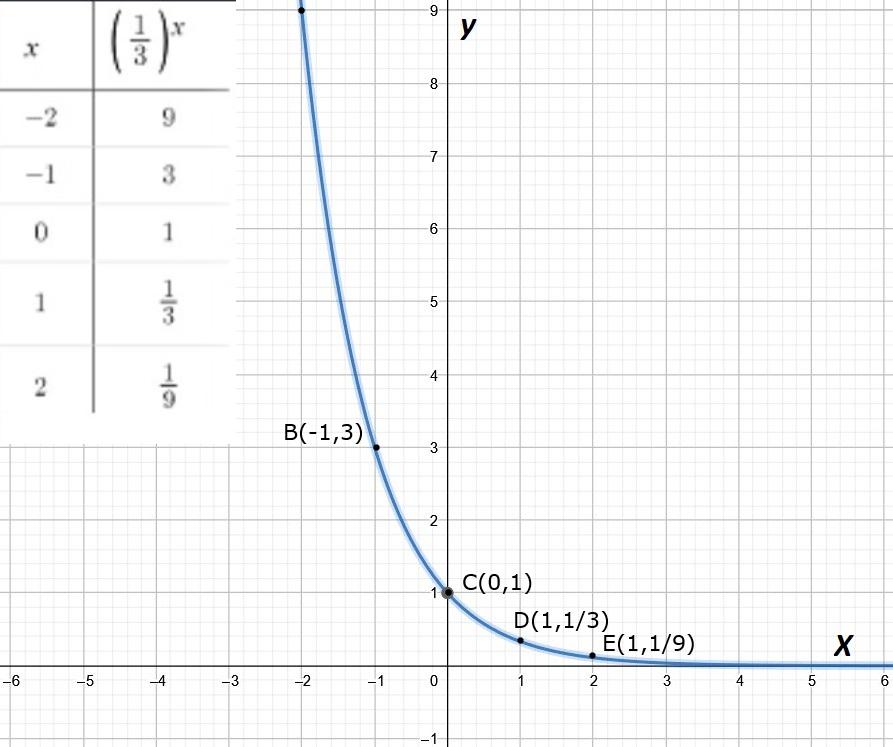
Page 56 Problem 10 Answer
Given
Linear function f(x)=m x+b
Exponential function f(x)=a⋅bx
Quadratic function f(x)=ax2+bx+c
Linear Absolute Value Function f(x)=a∣x+b∣+c
To create an equation and sketch a graph that has a minimumis discrete, andis a linear absolute value function
Using concepts of graph and relationships.
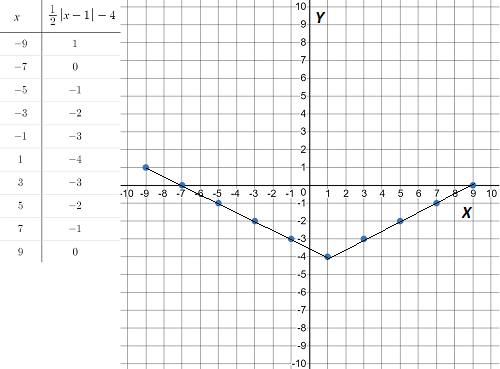
The function must be a linear absolute value function so the equation is f(x)=a∣x+b∣+c
As it is discrete, the domain is the integers.
As the graph must have an minimum, it must open upwards soa>0
The values of b and c can be any number between−3 to 3.
The possible function is f(x)=1/2∣x−1∣−4
The function according to the given condition is f(x)=1/2∣x−1∣−4
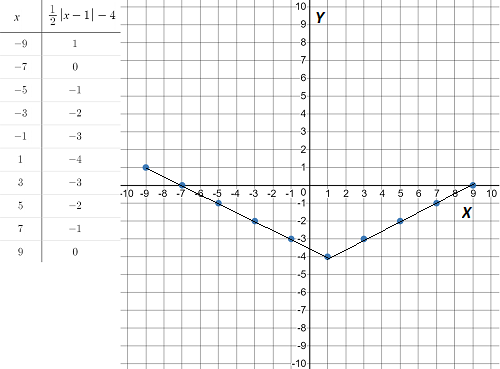
Page 56 Problem 11 Answer
Given
Linear function f(x)=m x+b
Exponential function f(x)=a⋅bx
Quadratic function f(x)=ax2+bx+c
Linear Absolute Value Function f(x)=a∣x+b∣+c
To create an equation and sketch a graph. is linear is discrete is increasing, and is a function.
Using concepts of graph and relationships.
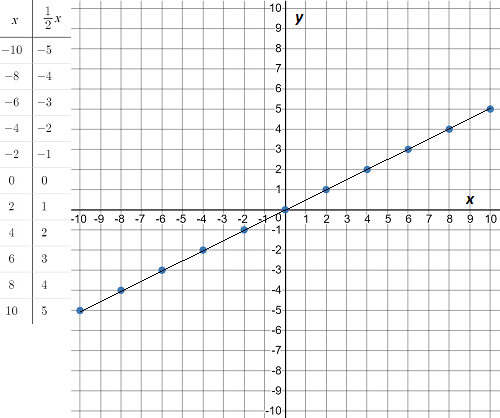
The function must be linear so the equation isf(x)=mx+b.
Since it is discrete, the domain is integers.
Since it is increasing,m>0.
A possible equation could then be f(x)=1/2x.
The equation according to the given condition is f(x)=1/2x
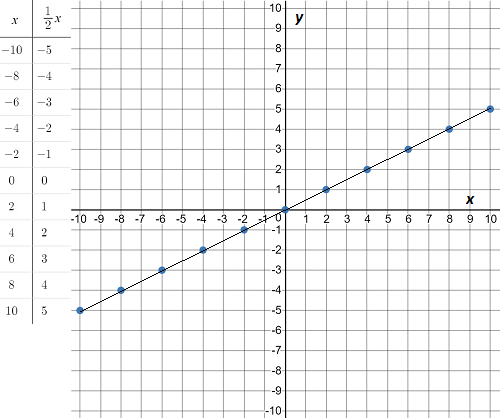
Page 56 Problem 12 Answer
Given
Linear function f(x)=mx+b
Exponential function f(x)=a⋅bx
Quadratic function f(x)=ax2+bx+c
Linear Absolute Value Function f(x)=a∣x+b∣+c
To create an equation and sketch a graph. is continuoush as a maximum is a function, and is quadratic
Using concepts of graph and relationships.
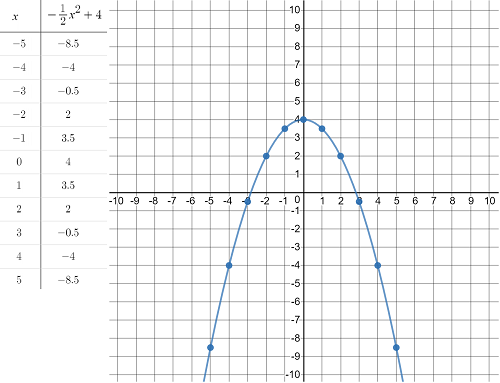
The function must be quadratic so the equation isf(x)=ax2+bx+c.
As it is continuous, the domain is real numbers.
Since it must have a maximum, the graph must open downward so a<0.
A possible equation could then be f(x)=−1/2x2+4.
The equation according to the given condition is f(x)=−1/2x2+4
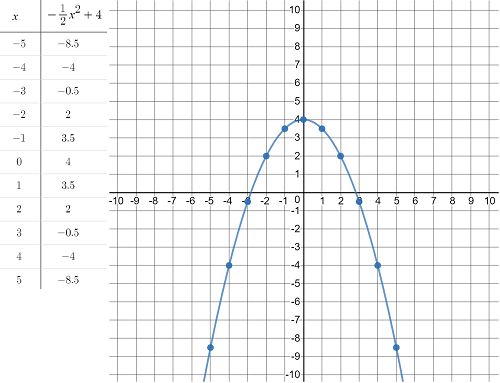
Exercise 1.4 Quantities And Relationships Explained
Carnegie Learning Algebra I Student Text Volume 1 3rd Edition Chapter 1 Exercise 1.4 Quantities And Relationships Page 56 Problem 13 Answer
Given: Linear function f(x)=mx+b
To create an equation and sketch a graph that it is not a function and is continuous, and is a straight line.
Using concepts of graph and relationships.
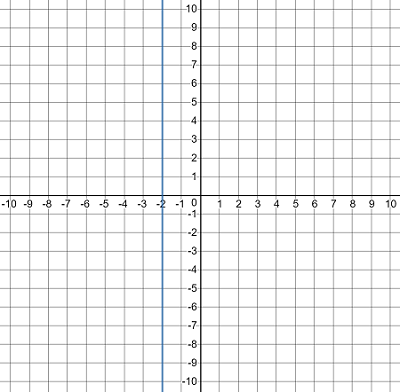
To create an equation and sketch a graph that it is not a function and is continuous, and is a straight line.
The equation must not be a function, must be continuous, and must be a straight line.
The equation must then be a vertical line of the form x=k where k is between−3 and 3
since all other straight lines are linear functions.
A possible equation could then be x=−2.
Graph a vertical line passing through−2 on thex−axis to graph this equation.
The equation according to the given condition is x=k
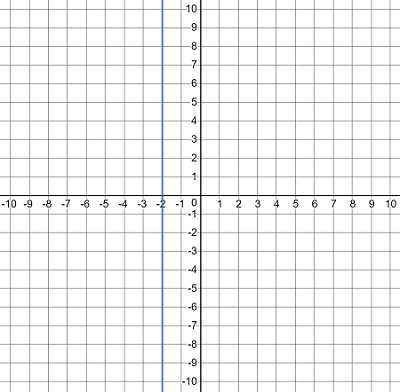
Page 59 Problem 14 Answer
Given: characteristics of the function To Create your own function.
To Describe certain characteristics of the function and see if your partner can sketch it.
To sketch your partner’s function based on characteristics provided.Using determination method.
The possible characteristics of the graph has a maximum , continuous, and is a linear absolute value function.
Since, the function must be a linear absolute value function, the equation must be V- shaped.
Since, it is a maximum it must opens downwards.
Since it is continuous, the domain is all real numbers so the graph must be have connected points.
A possible graph is
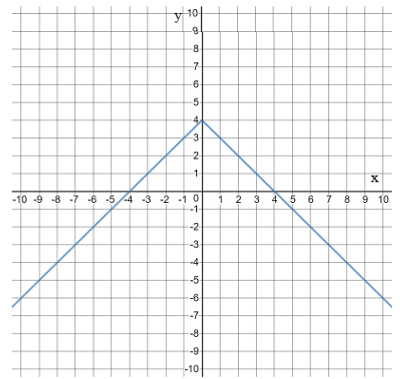
The possible characteristic from your partner is discrete, has a minimum, and is quadratic.
Since the function must be quadratic, the graph must be U- shaped.
If the graph has a minimum, its open upward
Since the function is discrete, the domain is the set of all integers.
The graph must have points not connected by a line or curve.
A possible graph
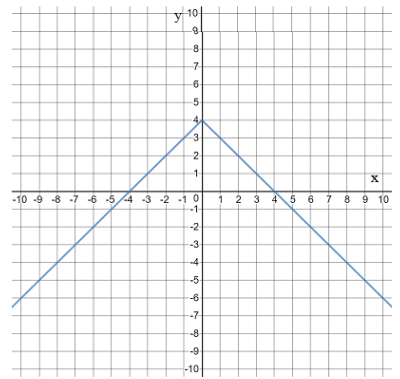
The possible characteristic for your graph has a maximum, is continuous, and is a linear absolute value function.
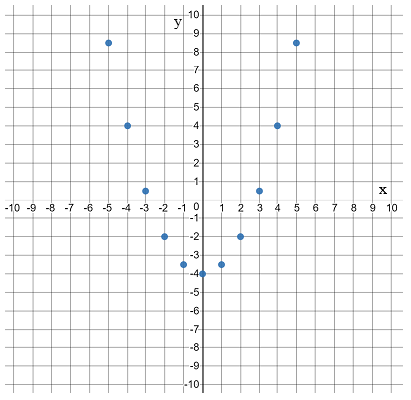
The possible characteristic from your partner is discrete, has a minimum and is quadratic.

Chapter 1 Exercise 1.4 Carnegie Learning Guide
